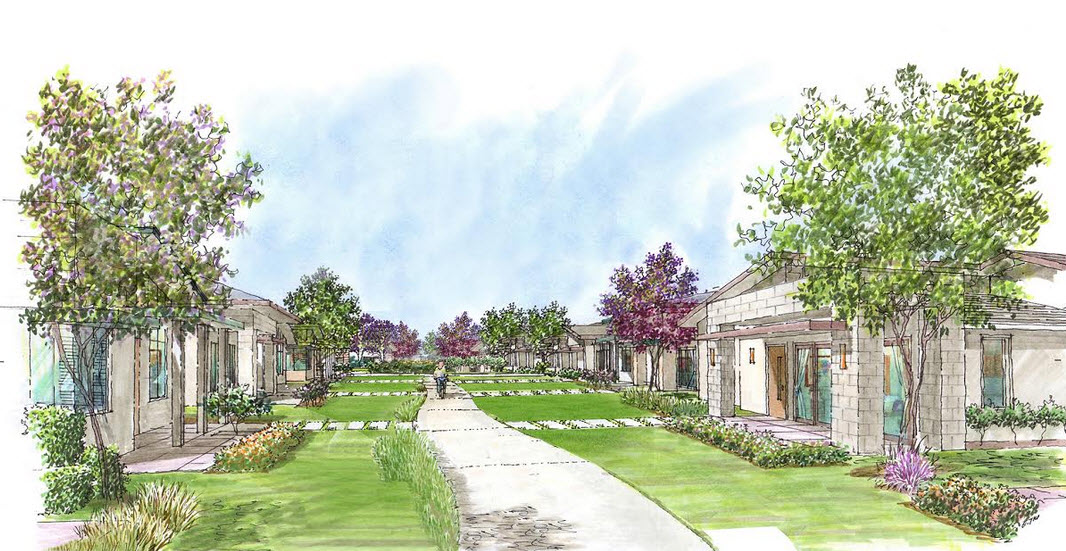
Council has until mid-June to put the West Davis Active Adult Community on the ballot, but, based on the discussion from the planning commission, there is still work to be done – even as many remain favorable toward the project itself.
The commission fell just shy of a full recommendation – able to unanimously recommend the certification of the EIR and Prezoning and Preliminary Planning Development, they supported recommending approval of the General Plan Amendment on a 5-2 vote with Cheryl Essex and Darryl Rutherford opposing, but they voted 5-2 against recommending approval of the Development Agreement, with only Stephen Mikesell and Herman Boschken supporting.
As a practical matter, that will not stop the project from being heard in late May as scheduled, but it does indicate there is more work to do – which was the feedback from the commission regardless.
The project consists of 560 units that are mostly age restricted to households 55 and over, but it does have 77 single-family units that have no such restriction. There are 150 affordable apartments for seniors – anticipated to be limited to occupancy by persons aged 62 or older.
Developer David Taormino explained, “We want to provide older Davis residents choices to stay in Davis.
“They should be able to stay here,” he explained. “Every community ought to be providing the type of development that we propose. In fact, I believe it’s a prototype for smaller communities so we don’t have to have people move from where they’ve grown up, where their children have been and where they want to stay.”
don’t have to have people move from where they’ve grown up, where their children have been and where they want to stay.”
He added, “I think it’s going to be a roadmap for future Measure Rs in terms of the approach we’ve taken.”
Mr. Taormino noted that the homes here are about half the size of the typical subdivision that’s being built, and he said that they have “rightsized homes for both active adults as well as young families.”
Ken Anderson from KD Anderson & Associates noted that there is minimal impact on traffic due to the traffic patterns of seniors. They had a chart showing that the average Davis single-family residence generates around 12.82 vehicle trips per day, but the national average for detached senior residential is at 4.27 trips per day.
He added that there is no appreciable difference in the traffic impact during peak hours, where they project 5 to 7 seconds of impact on traffic during peak hours along Covell Boulevard.
Jason Taormino noted a criticism of the project, in that it lacks density. However, their chart shows that they have a density of 7.5 units per acre, which is greater by a good margin than Grande Village (4.7) and the Cannery (5.5), and comparable to Chiles Ranch (7.9).
David Thompson pointed out their proposal has “three times the amount of affordable housing than is required by city standards.” He added, “There is a tsunami of low income seniors that are coming along that we don’t have a way to deal with. If this doesn’t get approved tonight and doesn’t pass on the ballot, then there is no affordable housing for seniors planned in the future and nothing will be built until 2030 at least – there is a huge vacuum that has been caused.”
The lengthy public comment featured a large number of speakers with supporters greatly outnumbering opposition – including a number of people speaking in support who normally oppose development projects, such as Eileen Samitz and Colin Walsh.
However, the planning commission itself had a number of concerns.
Darryl Rutherford explained, “I have a big heart towards affordability issues. Folks dealing with the challenges of the crazy housing market we live in.”
However, he expressed concerns. “That being said, this is quite a large project – 150 (affordable) units and one location.
“I don’t know if I like this location of where this is,” he said. “(It is) isolated from the rest of the community. I’d like to see more integration of the affordability component.”
He said, “This is a tough one because I’m also struggling with (the financing issues). I’d like to see more assistance from the developer itself to help this project come to fruition.”
Cheryl Essex had a lengthy list of concerns and questions.
At the outset she said, “I really see the need for this project in the community – we keep wondering if we’re going to stay in our East Davis home in our big lot.”
She said, “I like the location for some reasons, and I don’t like it for others.”
She cited connectivity as a big problem with the project, noting that it has “less bus service than other places in the community.” She said, “We have poor bus service to this location.”
Ms. Essex wanted to see a commitment to an on-demand shuttle.
“I would expect this because it’s senior housing to have higher density and smaller lots,” she said. “It doesn’t seem like these are smaller lots.”
Herman Boschken noted that “there has been a lot of discussion by all of us about concerns about transportation in and out of the project.” He distinguished connectivity from access. He said that while the bus stop provides connectivity, “it offers much less access than an internal transit hub… somewhere located near the community center or somewhere towards the center of the project.
“We need to consider a number of things with regards to the context these people are going to be living in,” he said.
He mentioned the traffic on Covell and asked, “Do we want our older folks exposed to traffic along Covell? Seniors almost by definition are less mobile and less agile than they were in their 20s, 30s, and 40s and so on.”
Stephen Mikesell was supportive of the project, though he too had some quibbles with it. He said that the developer and his staff “have done a really Yeoman’s job of reaching out to the community.” He called it “a model that to be followed if for no other reason I am inclined to do what needs to be done to give the man and his firm a vote of the people on this project.”
He did say, “I am in complete agreement with Cheryl (Essex) and with Herm (Boschken) that there are connectivity and access issues – I think those issues are really probably unsolvable given the fact of where they’re located within the city. There are going to be some connectivity issues no matter what you do.”
Greg Rowe said that he has supported this project for some time, “but I have some doubts as to whether or not the project is ready for prime time.”
He cited similar issues to the affordable housing component and the transit hub.
He added, “I’m not willing to wait till the projects gets to the council to address those things.”
It would seem then that most people liked the concept of the project, and they appreciated the work by the developers to reach out to the community early – they went to all of the commissions at least twice to get early feedback and address concerns.
But there still seems to be some concern about some of the project’s details, particularly on the connectivity issue that all of the commissioners clearly cited.
So now, even without recommendation for approval on the developer agreement, it is expected that the project will go to council in late May and it would appear that the applicants have some work still to be done.
—David M. Greenwald reporting







It sure is interesting how there was a lot more criticism in this forum then in the Bicycling, Transportation and Street Safety Commission – of which I am a member – and where I am on record stating that the project has no meaningful connectivity.
Still, in reference I want to call out the following:
What a disingenuous bunch of hooey! Seniors who can drive might do so in disproportionate numbers – hence the 97.85% driving modal share projected for WDAAC in the DEIR – but what these two things in aggregate tell me is that it can be difficult for seniors to leave by any means, and the relative extreme isolation of this development given its less mobile population is an appeal to the sensible citizen to easily vote against the project without remorse.
So here’s my constructive and hopefully warmly-considered suggestion for the Taorminos, their partners, the City Council (candidates), the Planning Commission and Planning staff: There is some movement at the conceptual level to make the Civic Center Plaza area – A St. to B St. 5th to 7th, plus B St. to C St. 5th to 6th – part of the Downtown Davis project. Start to work NOW to transform the WDAAC into something less waacky by pushing for it to be re-imagined for the Civic Center Plaza (!), with just as much elder housing – and thanks for proposing above minimum for affordability, by the way – but also housing for other challenged groups, with an exemption on any parking minimum requirement that still exists* when this proposal becomes a real thing in order to keep costs down and minimal bad mobility impacts assured. “Downtown Davis Active Adult Community” sounds like a perfect match for the cover of a near future monthly magazine of the AARP.
Supporters of this concept should participate earnestly in the Downtown Davis Participatory Design Workshop at Davis Community Church April 24 to 28 to take the first steps to make this happen. It will have my full support.
*I’ve proposed starting a sub-committee in the BTSSC to look into the idea of eliminating parking minimums for new developments – residential and commercial – a highly regarded tool for increasing sustainability and conviviality in towns large and small. We’re discussing this tonight at our monthly meeting – please come to the Senior Center (west entrance) at 5:30pm tonight to show your support during Public Comment — the item will be discussed at the end of the evening, however.
“What a disingenuous bunch of hooey! Seniors who can drive might do so in disproportionate numbers – hence the 97.85% driving modal share projected for WDAAC in the DEIR”
So you think their traffic analysis is wrong?
OK, I realize I did not make it clear: Since senior housing is not a big contributor to congestion, it’s because seniors are simply are not able to easily travel much – so my conclusion is that this means they need to be within safe walking distance of real, diverse destinations – i.e. not only automobile-oriented shopping centers they can reach by crossing a freeway. This is supported by the “20 Minute Village” link later in the article.
There is nothing wrong with the data, but I think seniors want to go places and not just stay at home. (Further, my personal experience in my own family is that the seniors or almost-seniors who move to isolated or peripheral places say that they’ll be fine later on since they can eventually take a shuttle to shopping etc. but that since this is obviously in no similar to the freedom they had by driving, they will in the end resist giving up their license for a long time, possibly causing danger to themselves and others.)
Thank you for clarifying that point.
I want to reinforce Todd’s point from a personal perspective. My mother and her husband lived rurally. This was fine for many years when his vision was good and his reflexes quick enough to be safe behind the wheel, probably until about age 70. After that he went into a sharp safety decline, insisting on driving for years beyond the point of safety. Ultimately he had to have all the keys to the car removed, which essentially ended their independent outings.
In my case, I made the decision 7 years ago to downsize to an easily walkable distance from downtown. I did this in anticipation of the time when my eyesight became limited ( family history). I am now starting to become less confident of my night vision & am limiting my driving mostly to daytime in anticipation of worsening. I have had many, many patients who continue to drive well past the point of safety.
I favor this project if, and only if, some agreement can be made about improving transportation for seniors as a defined and committed part of the arrangement.
I’m astounded by both numbers: 12.82 trips and 4.27 trips per detached housing for what I suppose are “regular” and “senior” households. How are these trips defined? Is a “trip” defined as a single round trip from home to destination and back; or, would a one-way home-to-destination A, destinationA to destinationB, and destination B to home be counted as three trips? Do these trip numbers reflect an average annual or seasonal variations. After all, I’m well into my senior status and there are days when the car doesn’t move and we live out on the edge of Mace Ranch.
I wonder if those trips are measured per household versus per capita? That might be a key factor.
Dave H and David G… “depends” on what your focus is…
Quick and dirty primer…
Trips have an origin and a destination. Generally for SF & MF uses, it is per DU, with assumptions of average occupancy (in Davis, avg. is ~2.5 persons per DU)… there can also be assumptions about ‘mode’… usually assumed to be MV, unless a particular study is looking for particular issues. Usually a trip is from source to ‘attractor’ and back, depending on what is being studied, which, for congestion on segments is generally focused on what the ‘peak hour’ trips are, generally assumed to be 10% of daily trips.
In Dave H’s example, the trip from A-B is a “pass-by” trip… sort of doesn’t count, except for site B (driveway volume)… so, going to Sutter from home, and stopping @ Nugget on the way home has neglible difference on the segment from home to A, B to home. Still ‘two trips’ for the “segments”. One out, one back. Unless the segment is different… might be one trip out on one segment, one trip back on another segment.
It depends… unless you are doing something special, it is Average Daily Trips (ADT)… M-F results may differ from Sat-Sun trips. Your results may vary, and may differ considerably from household to household in any given neighborhood. But, in the aggregate, over longer periods of time, the numbers cited look reasonable. (I’d tend to use [MV], 10-12 per SF DU ADT, M-F; 7-8 [MV] per MF DU, depending on circumstances… age, location compared to employment/shopping, would have me consider different numbers).
Anyone who wants to use a microscopic precision to understand how the universe works… well, there are some problems inherent in that…
Feel free to Google ITE Trip Generation Rates and dig into the details… the books I used (over a 30 year period) were a total of ~ 3 inches thick, and tempered by experience, actual local studies, etc.
Hope that helps a bit… know it will not answer all questions…
After all that, I still feel the numbers are on the high side. I live at the top of a cul-de-sac near Wildhorse and Mace Ranch (in other words, far from what most people would consider walkable or bikeable services) and view all the trips in a day and, on average, I’d say it would be hard to match those numbers. No, I haven’t collected any data. Yes, I would have to do that to substantiate my contention. Thanks for taking the time to elucidate.
Eileen spoke in favor of this project?
Yes
It is an upside down world.
Nothing new… at Yorktown the surrendering British played, a song “the World Turned Upside Down”